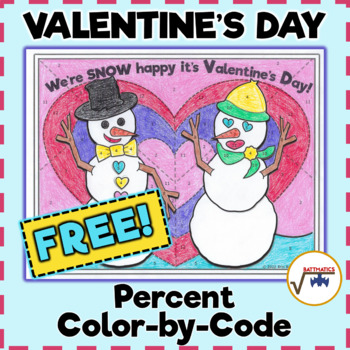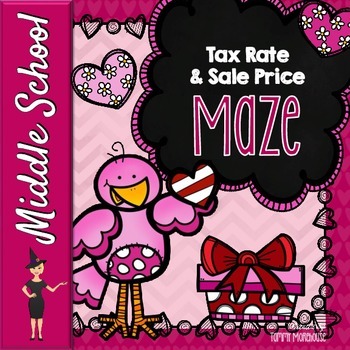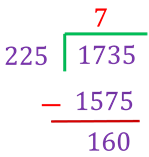
Valentine’s Day is fast approaching and that brings ample opportunity to incorporate fun Valentine’s Day math activities into your classroom! While math can be a touchy subject among students, especially for middle and high schoolers, using holiday-themed activities to reinforce concepts being taught in the classroom is extremely effective in keeping student interest.
With the abundance of Valentine’s Day math activities available, we know it can get stressful trying to find the right options for your classroom. To help, we’ve compiled four fun and effective activities you can use without spending any money. Integrating any of the following Valentine’s Day math activities into your class day is sure to brighten a classroom’s mood.
Plus, we’ve also included a set of original Piqosity Valentine’s Day math questions to put your holiday math knowledge to the test!
1. Valentine’s Day Hidden Message

The first of our Valentine’s math games is this middle school math activity which reviews the process for solving two-step math equations.
Students will be presented with a riddle (“what the calculator said to the student”), and a hidden message which answers the riddle. To unlock the message, they will need to solve a series of equations, each of which gives them part of the solution—one letter in the hidden message. After solving each equation, students will uncover the hidden message. Although your middle schoolers may groan at the punchline, they’ll have successfully practiced solving for variables. It’s a win-win for everyone involved!
For a more involved follow-up activity, have your students create their own riddles and set equations to solve their hidden answers. Then, they can exchange puzzles with a classmate!
Created and made available by Middle School Math Corner.
2. Snowman Valentine – Percentages and Decimals

Looking for an activity to practice decimals and percentages? You’ve found it with this color-by-code activity sheet! Your middle school students will work to solve each individual problem and use the solutions to fill in a color code chart as they go.
After finding the answer to each problem, your students will refer to the chart and write the corresponding problem # next to the answer. Once they have finished all of the math problems, students will then go back to the completed color code chart and use the information gathered to color in a Valentine’s Day-themed picture. This activity is perfect for a morning warm-up, as the problems aren’t overly taxing and the amount of time it should take to complete the work is not excessive.
Created and made available by Battmatics.
3. Valentine’s Day Math Maze

For more practice with tax rates and calculating total sale prices, consider using this Valentine’s Day math maze. Your students will be responsible for calculating the final price for each item listed in the maze after adding 8.5% in sales tax. As they solve each problem, they’ll color in the correct path that will lead to the maze’s finish line.
This activity is ideal for general review, morning warmups, or students who tend to be early finishers. To simplify the grading process, the creator of this activity also includes an answer key for you to refer to.
Created and made available by The Morehouse Magic.
4. Equation Matching Heart

Having the ability to correctly solve two-step equations is integral to succeeding in algebra and calculus classes. However, solving equations that require multiple steps can be stressful, especially for students who struggle with math. If this applies to your classroom, consider using this fun two-step equation puzzle activity with your students.
There are 20 total equations, each written on a half of a heart. Students need to solve each equation and find the corresponding other half to connect the heart back together. (There’s an included answer key to streamline the grading process.) Consider using the same idea to create Math Valentine’s cards! Pass out one heart half (with either an equation or solution) to each student. Then, have them find their “Valentine partner” by solving their equations – you could even award prizes to the fastest-solving team!
Created and made available by Is This For a Grade.
Valentine’s Day Math Questions by Piqosity
Piqosity’s own Mohamed El Noamany has developed the following mathematics questions, of increasing difficulty and covering a variety of subtopics, to test students on some crucial math skills while maintaining a seasonal bent. Print out copies of this section and you’ve got ready-made Valentine’s day math worksheets to hand out to your students!
Valentine’s Day Math Questions
A school hosts a Valentine’s day event where students can send carnations, cards or cookies to each other.
1. If each carnation costs $2.25 and Matthew has $17.35, how many carnations can he buy?
A. 5 carnations
B. 6 carnations
C. 7 carnations
D. 8 carnations
2. Ms. Flores is in charge of baking the cookies for the Valentines day event. If she needs 1.25 cups of sugar to make a batch of 12 cookies, how many cups of sugar will she need to make a batch of 84 cookies?
A. 7 cups
B. 8.75 cups
C. 4.5 cups
D. 9.25 cups
3. Tina is in charge of handing out the Valentine’s day cards. If she has a box filled with 8 cards and 3 of them are for her. If she removes the cards one at a time from the box, what is the probability that the first 3 cards she removes are all for her? (Give your answer in simplest form.)
A.
B.
C.
D.
Math Answer Key and Explanations
1. C. 7 carnations
In order to find the total number of carnations Matthew can purchase, we will need to divide the total amount of money he has by the cost of each carnation.
Set up the division problem.
Convert the divisor into a whole number.
Divide.
Since we are looking for the whole number of carnations that Matthew can buy, we can stop here. He has enough money to purchase 7 carnations and he will be left over with $1.60.
2. B. 8.75 cups
We know that a batch of 12 cookies takes 1.25 cups of sugar. In order to find the amount of sugar required for a batch of 84 cookies, we can set up a constant proportion and solve for the amount of sugar needed for 84 cookies.
![]()
Cross multiply the denominators and solve for x.
![]()
This tells us that a batch of 84 cookies will need 8.75 cups of sugar.
3. A.
In order to calculate the probability of a single event happening, we create a fraction with the numerator being the chances of the desired outcome happening and the denominator being the number of possible outcomes.
In this case, we want to find the probability that the first 3 cards Tina selects are for her. Since we know that there are 3 cards in the box designated for Tina, and there is a total of 8 cards, when she selects her first car she has a probability of that the card she selects is for her.
When Tina is selecting her second card, there are now only 2 in the box with her name on it, and a total of 7 cards in the box. This means that the probability of selecting a card for herself is .
Finally, when she is selecting her third card, there is only 1 card left with her name on it in a box of 6 cards. This means the probability of selecting her card is .
Since we are calculating the probability of multiple events happening in succession, we will need to multiply the probabilities together.
This means that the probability of the first 3 cards being for Tina is .
Find More Math Resources Like These at Piqosity!
We hope you found these fun Valentine’s Day activities insightful and resourceful for your classroom, both in their engaging celebration of the holiday and in the plentiful opportunities to sharpen key math skills for students. And make sure to check out for our ELA Valentine’s Day Classroom Activities, focused on developing reading comprehension and other English Language Arts skills!
You can find more (non-themed) math lessons with questions of similar difficulty levels in our Math Courses! These are complete courses available online through our app and can be purchased separately or received for free when bundled with our ISEE test prep courses!
- 5th Grade Math Online Course
- 6th Grade Math Online Course (Coming Soon)
- Pre-Algebra Online Course (Coming Soon)
- Algebra I Online Course
- Algebra II Online Course
For your convenience, we have outlined lessons relevant to or at the same difficulty level as the above questions. These can be found below.
Related Math Lessons by Piqosity:
Lessons related to question #1:
Lessons related to question #2:
Lessons related to question #3:




